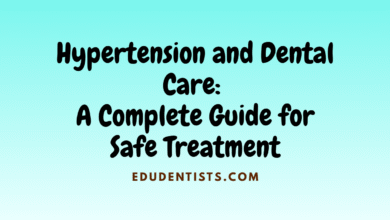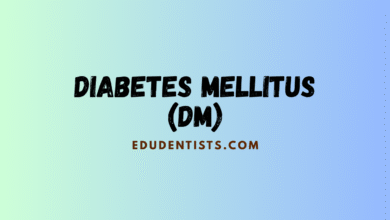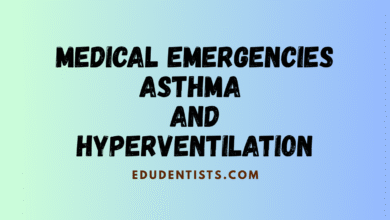Complications Associated with Dentoalveolar Surgery
Complications Associated with Dentoalveolar Surgery

Complications Associated with Dentoalveolar Surgery
Dentoalveolar surgery, while routine, carries the risk of several postoperative complications. A thorough understanding of their etiology, risk factors, prevention, clinical features, and management is crucial for both dental students and practicing clinicians.
Dental MCQs – Complications in Dentoalveolar Surgery
1. Postoperative Bleeding
Etiology & Prevalence
✦ Bleeding is a common side effect of dentoalveolar procedures.
✦ In healthy patients, it is usually minimal and self-limiting due to clot formation.
Types:
- Oozing: minor, resolves within 36–72 hours, controlled by pressure.
- Active bleeding: profuse, mouth fills rapidly with blood once gauze is removed.
Risk Factors & Prevention
✔ Careful medical history is critical:
- Systemic disorders: hemophilia, von Willebrand disease.
- Medications: aspirin, clopidogrel, warfarin, heparin, newer anticoagulants (rivaroxaban, apixaban, dabigatran).
- Family history of bleeding.
- Female patients with menorrhagia.
✔ Notes on anticoagulants:
- Aspirin/NSAIDs/clopidogrel → usually safe to continue.
- Warfarin: safe if INR < 2.5 (multiple extractions) or < 3.0 (1–3 simple extractions).
- Consider staged visits.
- New anticoagulants: safer, fixed dosing, but costly.
Treatment
- Intraoperative: gentle tissue handling, vasoconstrictors, primary closure, topical hemostatics.
- Postoperative: gauze pressure, remove “liver clot,” vasoconstrictors, hemostatic packs + sutures.
- Severe cases: arterial ligation, electrocautery, or embolization.
2. Postoperative Pain
Etiology & Prevalence
- Onset: 6–12 hours post-op (after LA wears off).
- Peaks: 24–48 hours.
Prevention & Management
✔ Minimize surgical trauma and flap tension.
✔ Pre-op NSAIDs (salicylates, COX-2 inhibitors).
✔ Post-op:
- NSAIDs = first line.
- Opioids + acetaminophen (hydrocodone, oxycodone, tramadol) for severe pain.
- Long-acting anesthetics (bupivacaine + epinephrine) to delay onset.
3. Postoperative Swelling
Etiology & Prevalence
- Common and expected.
- Onset: 12–24 hrs → peaks: 48–72 hrs → subsides by day 4 → resolves within 1 week.
Prevention & Management
✔ Inform patients swelling is normal.
✔ Ice packs in first 24 hrs.
✔ Head elevation during sleep.
✔ Corticosteroids (for extensive surgery, e.g., 3rd molars).
4. Surgical Site Infection
Etiology & Prevalence
- Oral cavity contains mixed flora → risk of infection.
- More common with mandibular 3rd molars.
Risk Factors
- Older age, smoking, oral contraceptives, poor hygiene, pre-existing infection, surgical trauma.
Prevention
- Atraumatic technique, thorough debridement, irrigation, removal of necrotic tissue.
Treatment
- Symptoms: persistent pain, swelling, pus, trismus, foul taste, ± fever.
- Early cellulitis: broad-spectrum antibiotics.
- Abscess: incision & drainage + C&S.
- Severe spread: risk of airway compromise → emergency management.
📊 Summary Table: Common Postoperative Complications
| Complication | Onset | Peak/Duration | Main Prevention | Key Management |
|---|---|---|---|---|
| Bleeding | Immediate | Hours post-op | Risk assessment, hemostatic measures | Gauze, vasoconstrictors, sutures, arterial control |
| Pain | 6–12 hrs | 24–48 hrs | NSAIDs, gentle technique | NSAIDs, opioids + APAP, long-acting LA |
| Swelling | 12–24 hrs | 48–72 hrs | Ice, elevation, steroids | Reassurance, symptomatic care |
| Infection | Variable (days) | Progressive | Debridement, irrigation, risk assessment | Antibiotics, I&D, airway protection if severe |
5. Alveolar Osteitis (Dry Socket)
Prevalence & Etiology
✦ One of the most frequent complications after extractions, esp. impacted teeth.
✦ Incidence up to 30%.
✦ Caused by dislodgment or failure of clot formation (not infection).
Clinical Features
- Severe throbbing pain (3–5 days post-op).
- Halitosis.
- Trismus (from pain).
- Empty socket with exposed bone, erythematous margins, food debris.
- No fever or swelling.
Prevention
- Risk factors: age, smoking, poor hygiene, oral contraceptives, infection, mandibular extractions, inexperience.
- Measures: socket irrigation, medicaments (e.g., Gelfoam®, PRP, medicated rinses).
Treatment
✔ Self-limiting – focus on pain control.
- Warm saline irrigation.
- Medicated dressings (eugenol packs, changed every 24 hrs).
- Analgesics.
6. Fractures
Prevalence & Etiology
✦ Rare but serious; due to excessive extraction force.
✦ May affect alveolar bone or mandible → malocclusion, malunion, paresthesia, infection.
Prevention
- Higher risk in elderly (low bone density).
- Atrophic mandibles or with large lesions = vulnerable.
Treatment
- Clinical recognition: mobile segments, malocclusion, disproportionate pain/swelling.
- Imaging: periapical, panoramic, CT.
- Mild: dietary modification, immobilization.
- Severe: reduction and fixation.
7. Root Fractures
Prevalence & Etiology
✦ Common with multirooted posterior teeth.
✦ Caused by excessive force, poor root separation, root anatomy variations.
Prevention
- Correct technique, sectioning when needed.
- Recognize risky roots (curved, dilacerated, thin).
Treatment
- Inspect extracted tooth for completeness.
- Small, asymptomatic, <3 mm root tips without infection → may be left (coronectomy).
- If pathology present → careful removal with root tip picks, avoiding apical pressure.
8. Root or Tooth Displacement
Prevalence & Etiology
✦ Rare but distressing.
✦ Maxillary → fragments into sinus or infratemporal fossa.
✦ Mandibular → fragments into submandibular space or IAN canal.
Prevention
- Proper surgical technique (periosteal elevator as barrier).
- Radiographs to assess sinus/root proximity.
Treatment
- Maxillary sinus: localize via imaging, retrieval by sinus pressure, suction, gauze packing, or surgical exploration. Post-op antibiotics + sinus precautions.
- Mandibular: immediate imaging. Gentle removal if possible; otherwise, delay until fibrosis stabilizes fragment. IAN canal fragments may be left if asymptomatic.
9. Oroantral Communication (OAC)
Prevalence & Etiology
✦ Common after maxillary posterior extractions.
✦ <1% persist as fistulas.
✦ Caused by close anatomical root–sinus relationship.
Prevention
- Radiographic evaluation pre-op.
- Gentle curettage, avoid excessive apical pressure.
- Inform patient of risk if high.
Diagnosis
- Valsalva maneuver → air bubbles in socket.
Treatment
- Small defects: usually heal spontaneously.
- Supportive meds: antibiotics (amoxicillin, clindamycin), sinus precautions, nasal decongestants.
- Persistent OAC/fistula: surgical closure with layered repair + sinus management.




